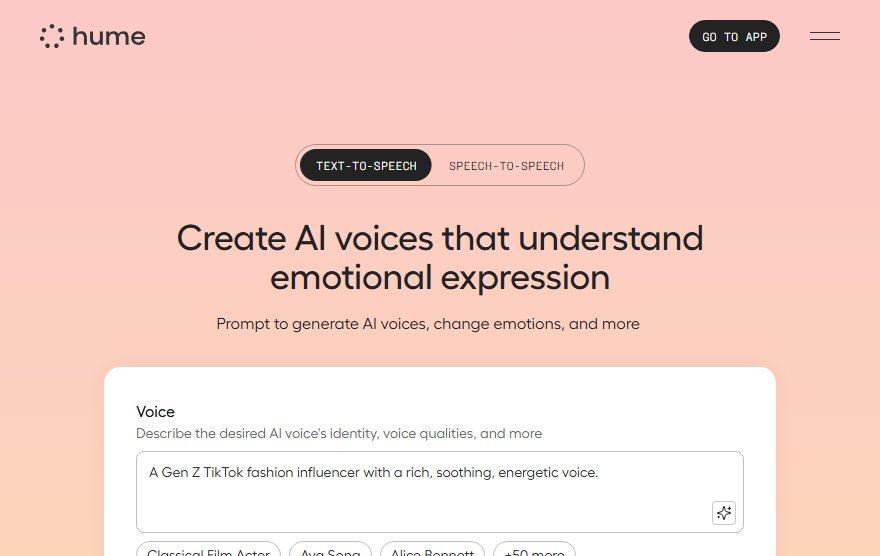Overview
Hume is an empathic AI research lab pioneering multimodal artificial intelligence that understands and responds to human emotions. Combining NLP, computer vision, and generative AI, Hume creates emotionally intelligent systems capable of transforming interactions between humans and technology. Whether it’s generating nuanced voice performances with emotional customization, analyzing facial expressions and vocal tones through its Expression Measurement API, or powering conversational AI agents with real-time empathy, Hume bridges the gap between raw data and human connection. Its versatile toolkit includes a TTS Creator Studio for crafting lifelike long-form audio and a voice interface that adapts dynamically to user emotions, making it ideal for developers, content creators, and businesses seeking deeper engagement.
Designed for storytellers, researchers, and customer experience innovators, Hume redefines how AI interprets and generates emotional context. Content creators can leverage its generative capabilities to produce voiceovers with authentic emotional resonance, while analysts gain deeper insights by measuring emotional responses across text, speech, and video. The platform’s conversational voice agents bring warmth to customer interactions, offering personalized support that feels genuinely human. By blending emotional intelligence with advanced AI, Hume doesn’t just process information—it understands the people behind the data, unlocking new possibilities for emotionally aware applications in entertainment, mental health, education, and beyond.
Key Features
- LLM-powered text-to-speech with emotional customization
- Real-time empathic voice interface for applications
- Expression measurement API for face, voice, and language
- Conversational voice platform for emotional AI agents
- TTS Creator Studio for long-form audio generation
- Voice library with 50+ pre-built character voices
- Emotion modulation (awe, joy, anger, disgust, etc.)
- Startup grant program for business integrations
- Developer tools including API docs and Discord support
- Multi-modal expression analysis (facial, vocal, linguistic)
Use Cases
Content Creation
Hume streamlines content creation by generating high-quality, engaging, and tailored content for various platforms, including blogs, social media, and marketing materials. Leveraging advanced natural language processing, the tool ensures originality, coherence, and relevance to the target audience. Whether drafting articles, crafting ad copy, or brainstorming creative ideas, Hume enhances productivity and creativity while maintaining a consistent brand voice.
Research and Analysis
Hume excels in research and analysis by quickly processing vast amounts of data to extract actionable insights. The tool can summarize articles, identify trends, and provide detailed reports on complex topics. With its ability to analyze both structured and unstructured data, Hume helps users make informed decisions, whether for academic research, market analysis, or competitive intelligence. It saves time and reduces manual effort while delivering accurate and comprehensive results.
Conversational Assistance
Hume offers intelligent conversational assistance, acting as a virtual aide to answer questions, provide recommendations, and facilitate discussions. Its advanced AI understands context and nuances, enabling natural and meaningful interactions. Whether used for customer support, personal productivity, or team collaboration, Hume enhances communication efficiency. The tool adapts to user preferences, learns from interactions, and delivers personalized responses to improve engagement and satisfaction.
Target Audience & Industries
Target Audience
Hume is designed for businesses, individuals, and students seeking to enhance productivity and decision-making through AI-powered insights. Businesses benefit from streamlined operations, data-driven strategies, and improved customer engagement. Individuals gain personalized recommendations, task automation, and efficient time management. Students leverage Hume for research assistance, study optimization, and academic performance tracking. The tool empowers all users with intuitive, AI-driven solutions tailored to their unique needs.
Target Industries
Hume is particularly valuable for industries like healthcare, finance, education, and retail. Healthcare providers use it for patient data analysis and predictive diagnostics. Financial institutions benefit from risk assessment, fraud detection, and investment insights. Educational institutions leverage Hume for personalized learning and administrative efficiency. Retailers optimize inventory management, customer behavior analysis, and marketing strategies. These industries gain a competitive edge through Hume’s advanced AI capabilities.
Evaluation and Review
Advantages
- Enhanced Emotional Engagement – The tool’s emotion modulation and empathic voice interface create more natural and emotionally resonant interactions, improving user experience.
- Versatile Content Creation – With TTS Creator Studio and a diverse voice library, users can generate high-quality, long-form audio content tailored to specific tones and emotions.
- Multi-Modal Analysis – The expression measurement API provides comprehensive insights by analyzing facial, vocal, and linguistic cues, valuable for research and user feedback.
- Developer-Friendly Integration – Robust developer tools, including API docs and Discord support, make it easy to integrate Hume’s AI into existing applications or workflows.
- Real-Time Conversational AI – The platform enables dynamic, emotionally intelligent AI agents for applications like customer service or virtual assistants.
- Business Support – The startup grant program lowers barriers for businesses to adopt and experiment with Hume’s advanced AI capabilities.
Limitations
- Emotional Customization Complexity: Fine-tuning emotional tones in text-to-speech may require trial and error to achieve desired results, potentially increasing setup time.
- Data Privacy Concerns: Multi-modal expression analysis (e.g., facial, vocal) may raise privacy considerations for users, depending on data handling policies.
- Integration Learning Curve: Developer tools, while robust, may require technical expertise to fully leverage, especially for complex business integrations.
- Resource Intensity: Real-time empathic voice interfaces or generative AI features could demand higher computational resources, impacting performance on low-end devices.
Other Information
Domain Info
Created at: 2020-04-06
Expires at:
Interest over time
Worldwide. Past 90 days. Web Search.

